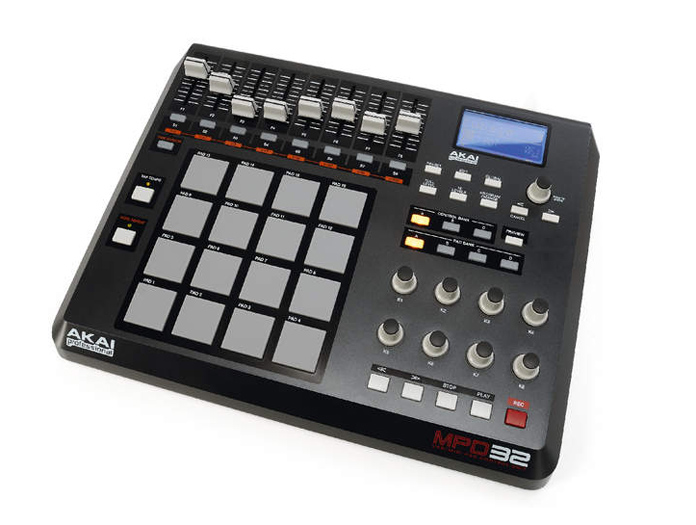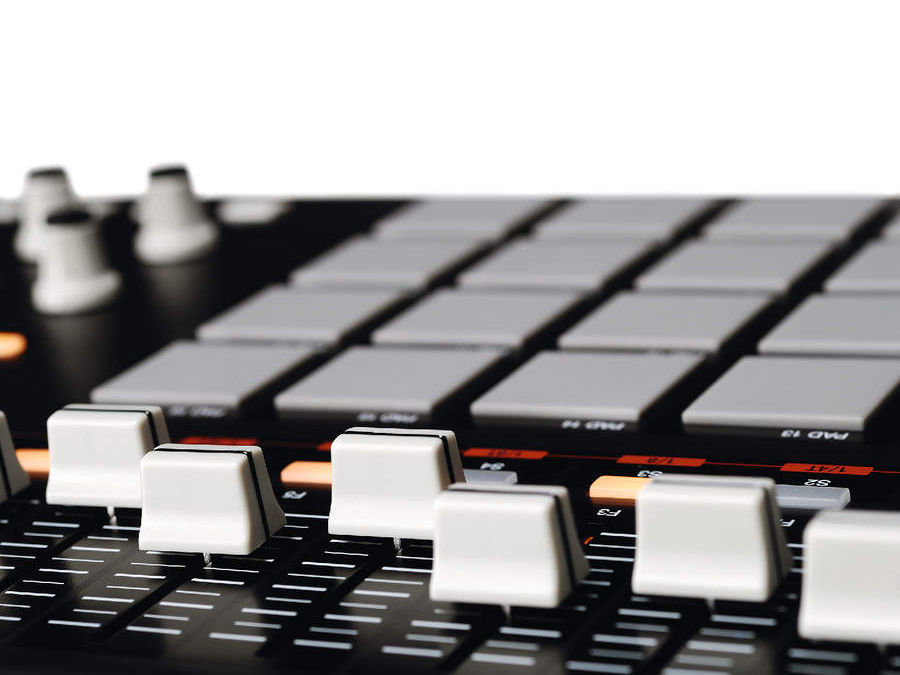MusicRadar Verdict
A flexible controller for studio and performance use - computer users who want MPC-style functionality should snap it up.
Pros
- +
Quick to set up and edit. Uncrowded controller surface. Wide range of parameter assignments.
Cons
- -
No power supply in the box.
MusicRadar's got your back

Akai MPD32

Akai MPD32
With the audio production market now full of control surfaces, Akai is relying on the classic look of its MPC range to make the MPD32 stand out from the crowd. It´s bigger than its predecessor, the MPD24, offers more controls and sports a more pleasing black/dark grey colour scheme.
The DAW control features have been expanded too, but can the MPD32 serve as useful partner for your sequencer and as a drum/MIDI programming tool?
Overview
As with the MPD24, this unit is a USB beast that can be bus powered, although when used in a standalone MIDI mode, a 6v DC supply is needed (though isn´t supplied).
Once plugged in the unit shows up as three separate USB/MIDI devices. This means that 48 MIDI channels can be utilised to create a wide-ranging DAW control, MIDI instrument triggering and program/parameter change structure without having to get too conservative.
Of course ‘wide ranging´ can also mean ‘confusing´, and this is where a well-made menu/edit system can make all the difference - a point that shall be addressed once we´ve taken a tour of the broad interface.
As well as the 16 MPC-style pads, eight rotary knobs and eight faders (with eight lit toggle switches beneath) there are three more input possibilities: rear jack sockets for one expression pedal and two footswitches.
The final controls come in the form of a transport section (record, play, stop, forward and rewind). These can communicate transport information with software via four different protocols: CC number, MMC, MIDI/ SysEx, and a MIDI/MMC combination.
In use
The pads, faders and switches feel just like they always have on the MPCs, though the knobs have been altered as they can now rotate continuously. The controls all feel solid enough to endure a fair battering and the layout is quick to navigate, though the plastic chassis is a little uninspiring.
We worried that it might be difficult to get all the pads, knobs and faders doing what we wanted, but it turns out to be easy. Apart from a few global settings, most of the editing only involves one screen on the backlit display, which is accessed by pressing the Edit button after tweaking the knob/fader/ switch in question.
The pads and switches can be used to send program change messages, while the knobs and faders can be assigned to control aftertouch. All CC ranges can be set (ie, minimum and maximum values), which is essential to prevent overshooting on filter resonance control, for instance, or limiting DAW fader throws to peak at 0dB.
The MIDI programming side of the MPD32 keeps many of the familiar MPC functions. The 16 pads are extended by the four pad bank switches that allow for four sets of pad assignments - this is one of the functions that really helped the MPCs become such renowned performance tools.
The Full Level switch enables you to set all the pads to send velocity at 127, and 16 Levels maps the last pressed pad´s note number to all 16 pads with the velocity numbers increasing up the pads from 7 to 127.
Again, from the MPC side there is the Note Repeat function, which does what it says. The repeating can be assigned to either momentary or toggling behaviours, and Gate and Swing parameters are on the next edit page to make the most of those repeats. Tap Tempo and Time Division switches come into play here too, though tempo can be set per preset (ie, global setup) or to incoming MIDI clock.
Controlling your software
As a DAW controller, the unit is supplied with setups for a range of popular sequencers and soft synths (Live, Cubase, Sonar, Reason, Arturia´s synths, BFD and more), and the CD-ROM contains a selection of device map templates for these applications to make the setting up pretty much instant. Customising the MPD32 to control any other DAW or soft synth is simple.
Just as the pads have four banks, so the controllers (faders, knobs and switches) have their own Control Bank switches so you can select one of the three available banks. This gives the user 24 level faders, pan pots and mutes. Though the faders have a shorter throw than those commonly found on mixing desks, they are smooth, sturdy and have enough track to ride levels in a worthwhile fashion.
The knobs are also smooth and their placement means that they´re not crammed in between rows of other knobs and switches (as is so often the case) making them easy to access, an important factor when you want to get creative with a mix or synth.
The MPD32 has 30 preset slots available in its memory, with each preset containing a total snapshot of the controller assignments and ranges. However, there´s no real limit to the number of presets you can store as the hardware comes supplied with the Vyzex editor/librarian application. Just as it is on the unit, storing, loading and naming presets is simple and quick in the software.
Summary
On one hand, the MPD32 could be considered a fence-sitter, hedging its bets between MIDI programming/ performance and DAW control, but when used with certain applications - Ableton Live in particular - this dual functionality seems to make sense.
There are certainly more integrated DAW controllers on the market, but when it´s working in this role, the MPD32 is undeniably a useful product. As a MIDI/drum programming and performance tool for those working with computer and MIDI-based instruments, meanwhile, it´s flexible, well featured and quick to set up.
The MPD32´s top surface is simple and uncrowded - no surprise when you consider its substantial footprint - while the display provides just enough feedback for you to see what information you´re sending and to adjust parameters without wading through endless menu pages. In fact, our only real gripe is that no PSU is supplied.
It´s great to see the classic MPC design reapplied to the audio-free realm of control surfaces - the MPD32 is a useful, flexible and easy-to-use programming and performance tool.
Baby Audio's Smooth Operator spectral balancing plugin goes pro
"It was ugly, like watching a divorce between four people. After a while, I had to get out": Beatles engineer Geoff Emerick on the recording of Abbey Road, track-by-track
"I said, “What’s that?” and they said, “It’s what Quincy Jones and Bruce Swedien use on all the Michael Jackson records": Steve Levine reminisces on 50 years in the industry and where it’s heading next









